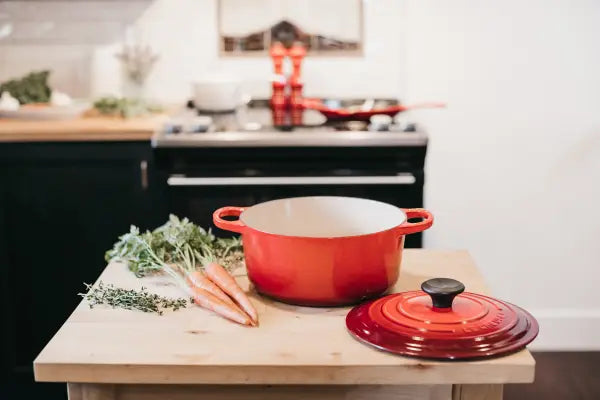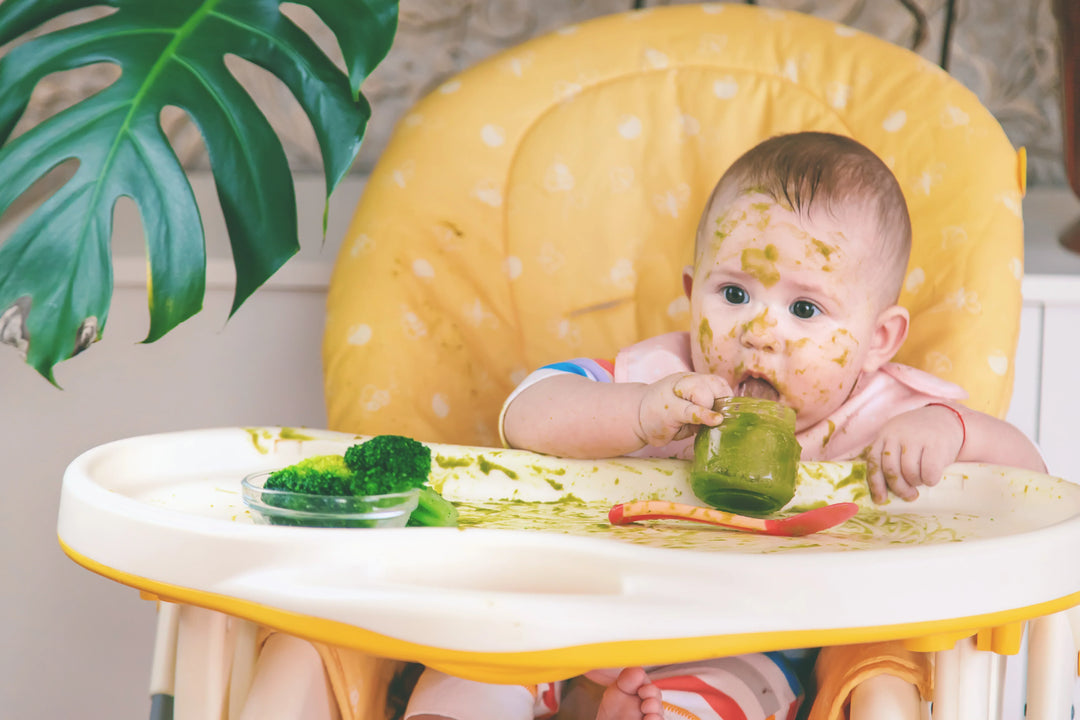Scared to Start Solids? A Pediatrician Shares What’s Normal, and How to Feel Ready

Starting solid foods is one of the biggest milestones in your baby's first year. It's exciting, but it can also feel scary. Many parents look forward to the moment when their baby takes that first bite of a banana or a spoonful of sweet potato.
But if you feel nervous about starting solids, you're far from alone. Most parents feel excited and worried at the same time.
Will my baby choke? What if I'm doing it wrong? Why does everyone around me have a different opinion about the "right" way to feed?
Between social media making it seem like every other parent has already figured it out, advice from relatives and friends, and pressure to "get it perfect," this milestone can feel like a parenting test you might not pass.
How to tune into your instincts when starting solids
Here's the good news: your feelings are normal. Every parent I know, myself included, has felt nervous about this stage. Even as a pediatrician, I remember the first time I gave my baby a piece of broccoli—I felt my heart skip a beat. I knew the recommendations, but the fear of choking was still there.
Over time, I realized something important: mealtime went best when I trusted my parental instincts and went at our pace, not what others said we "should" do. And I am here to encourage you to do the same in your own feeding journey: trust your instincts and let go of external pressures to follow one "right" path.
This article provides guidance for safe, flexible, and guilt-free ways to introduce solids, as well as how to approach mealtimes with confidence, compassion for yourself, and excitement for your baby.
Bottom line: there is no "one size fits all" method to give your baby a healthy, happy start with solid foods. And, Bébé Foodie is here to support you on your individual feeding journey, not add pressure.
Why starting solids feels scary for so many parents (and how to ease the worry)

The real fear behind starting solids: worries about choking and BLW
Does the thought of handing your baby a carrot stick make you nervous? You're not alone. The fear of choking is one of the top reasons parents worry about starting solids, especially with baby-led weaning (BLW).
To alleviate some of these fears, it helps to understand the difference between gagging and choking. Knowing the difference can give you confidence and help you stay calmer during meals.
Research shows that parental anxiety around feeding is common and deeply human, one recent study found that many parents experience heightened worry during the transition to solids and that these emotions can impact how confident they feel offering new foods.
Understanding that your fear is shared — and even studied — can be reassuring. You’re not overreacting or “too anxious”; you’re simply caring deeply about your baby’s safety.
Gagging vs. choking when starting solids: what parents should know
Gagging is a normal reflex that protects your baby. In the early months of eating, gagging is common. It might look scary, your baby might cough, their face might turn red, or they may spit food back out. But gagging is how babies learn to move food around their mouths safely. Most of the time, they work it out on their own. Intervening too quickly can actually increase the risk of choking. With practice, gagging decreases as your baby gets better at chewing and swallowing.
Choking occurs when food blocks the airway, requiring immediate action from the parent or caregiver. Unlike gagging, choking is usually silent, your baby might look panicked, struggle to breathe, or turn blue. Choking is rare, but it's still crucial for parents to recognize the signs and take safety precautions.
Knowing the difference between gagging and choking can give you peace of mind. Gagging may look scary, but it's a normal (and temporary) part of learning to eat.
When and how to start solids safely according to a pediatrician

Is your baby ready to start solids? Simple signs to look for
The American Academy of Pediatrics (AAP) recommends introducing solids around 6 months of age, but every baby develops at their own pace. Instead of focusing only on age, look for signs that your baby is ready, which include:
-
Sitting upright with little or no support
-
Good head and neck control
-
Showing interest in food (reaching for food, opening their mouth when food comes close, watching you eat)
-
Bringing toys or objects to their mouth with control
If your baby isn't showing these signs yet, don't worry. Waiting a few more weeks is perfectly fine. If you ever have concerns about your baby’s development, please consult with your pediatrician.
How to introduce solids safely: textures, first foods, and a calm start
The goal is to start with safe textures and sizes. Foods should be soft enough to squish between your fingers and shaped so your baby can pick them up.
Some great first foods include:
-
Ripe avocado slices
-
Steamed sweet potato sticks
-
Scrambled eggs
-
Soft, ripe banana
-
Very soft, cooked broccoli florets
There are many more foods that are great for Baby-led weaning. Most importantly, trust your instincts. You know your baby best. If something doesn't feel right or makes you nervous, wait until you're comfortable.
Worried your baby isn’t eating enough? Here’s what matters more
Parents often worry that their baby isn't "eating enough." It is important to remember that for the first year of life, breast milk or formula remains your baby's primary source of nutrition.
Solids are about learning:
-
Chewing and swallowing
-
Tasting and exploring flavors
-
Practicing motor skills
-
Building a positive relationship with food
Think of food as a form of play and practice in these early months. A few bites, smears, or licks are all normal. The most important things are exposure, practice, and positivity.
Starting solids your way: purees, baby-led weaning, or a bit of both

While there are a few common ways to start solids, there's no one "correct" way, it's about what works best for your family.
Different ways families begin starting solids (no one right path)
Purees:
Smooth purees, such as applesauce, mashed peas, or carrots. This method can feel less stressful at the beginning because the texture is predictable and easy to swallow. Over time, families transition to thicker textures and then move on to finger foods.
Baby-led weaning (BLW):
Emphasizes skipping purees and offering graspable, soft foods from the beginning. Many families appreciate this approach because it encourages independence and develops essential motor skills, such as grasping and chewing.
Combination feeding:
A flexible mix of both approaches. For example, you might spoon-feed purees while also letting your baby self-feed a slice of avocado. This adaptable method can help reduce stress for parents while still letting babies explore food on their own.
Bottom line: choose what works for you and your baby. If BLW feels overwhelming, you can start with purees. If you want to try both, that's great too. Most families end up blending methods in a way that fits their comfort level.
Baby feeding safety basics for starting solids with confidence
No matter which feeding style you choose, keep these safety basics in mind:
-
Posture matters: always feed your baby in a safe, upright high chair with good support. A footrest is helpful. Avoid bouncy or reclined seats.
-
Food size and texture: avoid small, hard, or sticky foods, such as whole grapes, nuts, popcorn, and spoonfuls of peanut butter. These can be choking hazards. For more on what constitutes a choking hazard, see the AAP’s choking prevention guidance at HealthyChildren.org.
-
Stay present: always supervise meals. Mealtimes are safer—and more fun—when you're engaged.
-
Learn infant CPR: while choking is rare, knowing what to do can build confidence and give you peace of mind. Many hospitals and community centers offer short CPR courses.
The heart of it all: start solids in a way that feels right for you
The first weeks of starting solids are as much about your learning as your baby's. It's normal to feel nervous, to overanalyze each cough, and to question whether you're "doing it right."
With time and practice, both you and your baby will get more comfortable. Trust your instincts and lean on the basics of safety.
At its core, introducing solids isn't about following a strict protocol. It's about helping your baby develop skills, confidence, and joy around food.
Whether your baby's first taste is a spoonful of puree, a slice of avocado, or a mix of both, what matters most is:
-
You're offering safe, nutritious foods.
-
You're creating a calm, supportive environment.
-
You're trusting your instincts instead of outside pressure.
At the end of the day, introducing solids is about helping your baby build confidence with food and making mealtimes a joyful experience. That's what your baby will carry with them long after their high chair days are over.


Written by Dr. Irini Kolaitis, MD
Pediatrician & Advisor at Bébé Foodie
Dr. Irini Kolaitis is a board-certified pediatric hospitalist in Chicago, with dual certification in General Pediatrics and Pediatric Hospital Medicine. With clinical expertise in food-related issues like anaphylaxis, feeding challenges, and nutritional deficiencies, she brings both professional and personal insight to Bébé Foodie. As a new mom, Dr. Kolaitis understands the ups and downs of introducing solids and supports our mission to make nutrition guidance simple and pressure-free for families.
This blog post is for information purposes only and shouldn’t be used as personal, health, nutritional, or medical advice. Always consult with your pediatrician before making any decisions about your child's health or readiness for various foods.



Leave a comment